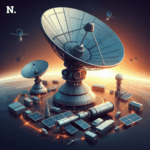In an unprecedented achievement in space engineering, the Chinese satellite, Jilin-1, recently performed a groundbreaking maneuver. This was done to prevent a potential catastrophe from an asteroid. This event has demonstrated the advanced space capabilities of China, particularly the versatility of the Jilin-1 satellite. It has also sparked discussions about the global implications and strategic concerns.
The Asteroid 1994 PC1
The asteroid, known as 1994 PC1, is a massive celestial body, comparable in size to San Francisco’s iconic Golden Gate Bridge. Tracking the asteroid’s path was a significant challenge for astronomers due to its enormous distance from Earth. The asteroid was located 2 million kilometers away, which is five times farther than the moon. This vast distance made it extremely difficult for astronomers to determine its exact path and assess whether it posed a threat to Earth.
The Role of the Jilin-1 Satellite
The Chinese Jilin-1 satellite, typically used for Earth observation, performed an extraordinary maneuver to aid in tracking the asteroid. In an unusual move, the satellite, which is usually pointed at Earth, aimed its camera into space. It started photographing the 1994 PC1 once every second, gathering important information.
The mission, conducted from January 17 to 21, 2022, involved 51 shooting tasks, each lasting 15 seconds. With the use of these photos, scientists were able to minimize the asteroid’s orbit positioning inaccuracy to just 33 kilometers. By two orders of magnitude, this greatly improved the precision of ground-based telescopes. Astronomers were able to verify that 1994 PC1 will pass past Earth without incident, removing any possibility of a collision.
Declassified Revelation and Its Implications
This operation was kept secret until the Chinese government recently decided to declassify it. The revelation has underscored the sophisticated capabilities of Chinese satellites. This has caused unease in Western nations. The concern is particularly high in the United States (US), as reported by South China Morning Post (SCMP).
There is growing apprehension that China’s expanding space capabilities could be leveraged for military purposes. This has the potential to disrupt the strategic balance in space. The project team is led by Professor Liu Jing of the National Astronomical Observatory of the Chinese Academy of Sciences. They have stated their future plans regarding space exploration. They intend to conduct follow-up experiments to observe fainter near-Earth asteroids using existing space-based equipment.
China’s Expanding Space Capabilities
The core of China’s Earth observation network is the Jilin-1 constellation, which has more than 100 satellites. These satellites are well-known for their quick, high-resolution imaging capabilities. They have been used to photograph complex objects like a rocket launch and an American F-22 fighter plane in flight. But detecting an asteroid millions of kilometers afar needed creative modifications, such as adjusting the optical sensors’ exposure characteristics.
NASA and the European Space Agency have been investigating the possibility of using specialized satellites for asteroid observation for some time. However, their plans are still primarily speculative. China’s successful experiment has demonstrated a new possibility in space exploration. It shows that current Earth observation systems can be repurposed to improve early warning capabilities for high-risk asteroids. This project includes sizable ground observation sites in Beijing and Xinjiang. In addition to these, a specific satellite for astronomical observation is also part of the project, highlighting China’s advanced space-ground collaborative capabilities.
Global Implications and Strategic Concerns
The US military is concerned about China’s space monitoring system’s rapid expansion, which includes the Jilin-1 satellites. General B. Chance Saltzman is the commander of space operations. He voiced concerns at the Space power Security Forum. His concerns were about China’s growing fleet of intelligence, surveillance, and reconnaissance (ISR) satellites.
Kelly D. Hammett, director of the Space Rapid Capabilities Office, also expressed these worries. He cautioned that the US may be lagging behind other countries in the space race. He underlined that China has a strategic dilemma. This is because a large number of its satellites are designed for use in space combat.
Notwithstanding these geopolitical conflicts, scientific and technical advancements continue to take center stage. An important first has been reached with China’s space program. They were able to use their Earth observation satellites for tracking asteroids in deep space. This achievement demonstrates China’s advanced space capabilities. It also opens up new possibilities for asteroid observation and disaster prevention.





